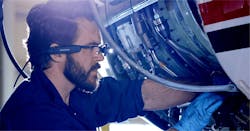Seven Tips to Retaining Retiring Worker Knowledge
Baby boomers reached a peak size of 66 million in the workforce in 1997 — the largest generation of workers ever — but have since dwindled to 41 million as of 2017, according to the Pew Research Center. Their ages in 2017 ranged from 53 to 71.
As one generation shrinks, another balloons. Millennials (those born between 1981-96) took over as labor force’s largest age group in the middle of this decade and numbered 56 million in 2017.
With more and more boomers retiring, they’re taking with them long-held beliefs, workstyles, and, in many cases, vast quantities of tribal knowledge. Losing the latter—that exclusive, often technical, product or process information that is stored inside someone’s head—is what will be most felt by the companies they are departing.
In the manufacturing world, this knowledge may be as simple as understanding why an eerie sound is emitted when a huge piece of expensive equipment warrants maintenance. It may be how to do makeshift fixes of key assets using tools, wires,and who knows what. It may be a technician who long ago came up with an obscure software workaround to enable old databases and servers to continue to interoperate. No one else may ever figure out how to keep this system running without an expensive new fix.
It’s in a company’s best interest to capture as much of this intelligence as possible to ease the transition to a newer, younger workforce — even if those workers don’t buy in to the way things were previously done.
The outflow of baby boomers and influx of millennials and soon Generation Z is taking place at the same time as massive technology changes impact industries, including the Industry 4.0 innovations. This confluence of events is destined to leave a knowledge gap and, likely, a skills gap ahead. Retaining or repurposing tribal knowledge for consumption by younger workers is indeed a challenge. The competitive advantage goes to companies that find ways to pull it off.
Here are some strategies to help:
Transfer knowledge the YouTube way Yes, encouraging the documentation of processes is smart, but doing it via the written word … not so much. Older workers generally don’t like writing instructions (and don’t always get them right). And many younger workers don’t care to pore over pages and pages of steps. Try using videos to share knowledge via YouTube, which has pioneered showing people how to do things. For example, documenting how to make sensors and software work together to provide asset conditioning monitoring data can be much more effective with a visual dimension. Your videos don’t have to be anything fancy (and don’t even have to go on YouTube). Make them simple and consumable and share with only those who need to know. Having a veteran maintenance tech wear enterprise-connected smartglasses and record their work is one easy way to do it.By collecting data and applying machine learning or natural language processing to analyze it for patterns and conditions, technology is essentially pulling exclusive information out of someone’s head and making it visible to teams. If you have workers writing daily logs or providing voice recordings that recap activities, getting them to tag key information using their tribal knowledge can help machine learning synthesize the unstructured data and turn it into valuable insights. Your new generation of workers is expecting that technology be applied this way to pass down information.
Today, the worker who got up at 3 a.m. to repair a machine is judged a hero. Maintenance teams that are always successfully troubleshooting problems are star performers. But what if machines rarely failed, and maintenance teams were free to attend to the needs of the whole operation, proactively? With computerized maintenance management systems (CMMS) and Industrial Internet of Things (IIoT) platforms, processes can be automated and maintenance more predictive. This enables companies to more efficiently manage assets, free up maintenance resources, and offset the loss of their longtime fix-it gurus.
Management can learn from newer generations and their affinity for applications and tools that are easy to operate and accessible from anywhere. Products from companies like Apple, Google, Amazon, and Microsoft have shaped their views on technology. Many, for example, prefer touchscreen functionality over knobs and dials. While it may be challenging to build the tools they will adopt, it’s time to start. This new, “consumerized” or “democratized” technology may lack decades of tribal knowledge, but it is here to stay. And it's best to make the change now while the both the experienced workers with tribal knowledge and the younger digital natives are all still in the plant to work together on making the transition the right way.
Image courtesy of Thinkstock.
Incentivize employees to learn from each other At many companies, resentment runs both ways. Older workers may be annoyed at seeing younger counterparts move in with new ideas and ways of working. Younger workers may begrudge the older generation for sticking around and delaying their chances for leadership roles and promotions. It’s not one generation immediately displacing another — the demographic shift is gradual, and seasoned employees will still be around for a while. There’s much to be gained by offering incentives for them to spend time together sharing and learning. Get creative here. There are several gamification companies out there ready and willing. It’s a win-win and the knowledge transfer does help the company. Getty ImagesFor at least the foreseeable future, companies will need people, as robots will only take over jobs that don’t require much thinking and analysis. Leaders will come from all the generations in the workforce, but the Gen Xers — those between the baby boomers and millennials — may be your best bet for driving change. They get the need for smart technology, but they also respect and value experience and tribal knowledge. In fact, they have much of their own.
About the Author
Oliver Sturrock
CTO
Oliver Sturrock is the CTO for Fluke Digital Systems (FDS). Prior to joining Fluke in 2017, Oliver served as CTO at SCHAD GmbH, leading a global team responsible for designing, developing and implementing enterprise software products enabling more efficient maintenance through the IIoT. Oliver specializes in creating customer-centric solutions in IoT; analytics; machine learning; real-time systems, secure web architectures and mobile. Oliver previously served as VP Mobile Solutions at OpenText (NASDAQ: OTEX), a leader in Enterprise Information Management, and Chief Technology and Strategy Officer of weComm Ltd (London, acquired by OpenText). Oliver has a BSc in Computer of Science from the University of York and has studied M&A and Business Strategy at the International Institute for Management Development (IMD) in Switzerland. He holds numerous patents for real-time data distribution over unreliable networks.



